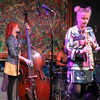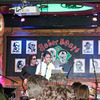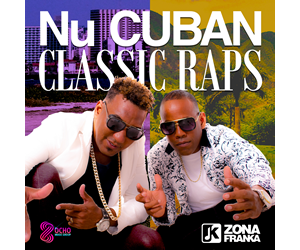Indice - Table of contents
Lo Nuevo[hide]
Reportes: From The St... : Jazz Plaza ...
Fotos: Tom Ehrlich : Irakere 50th Annivers...
Fotos: Tom Ehrlich : Irakere
Resenas: Joey Altruda Presents: El Gran ...
Reportes: From The St... : Cubadisco 2...
Timbapedia: 09. Interviews -... : Carlos del Pino ...
Fotos: Tom Ehrlich : 2023 Monterey Jazz Fe...
Fotos: Tom Ehrlich : 2023 Monterey Jazz Fe...
Fotos: Tom Ehrlich : 2023 Monterey Jazz Fe...
Fotos: Tom Ehrlich : 2023 Monterey Jazz Fe...
Grupos: Tirso Duarte
Grupos: Tirso Duarte : Discography
Grupos: Charanga Habaner... : 8. El bla bla bla
Grupos: Pupy y los que S... : Tirso Duarte
Fotos Del Día [hide]
The Music of Ritmo Oriental - The Art of The Bloque 1
The Art of the Bloque
Ritmo Oriental is to the bloque as Bach is to the fugue -- neither was the first or last to employ the device, but each elevated it to a level that has yet to be surpassed. The bloque at the end of the intro to Sabroseao con la Ritmo is our first hint at la Ritmo's mind-bending new approach.
All right then ... what's a bloque? Imagine a rollercoaster that threatens to throw its screaming occupants out of their seats as it hurtles around a turn, only to give them another big thrill as it accelerates into the next straightaway. So it is with a bloque -- the whole band stops keeping time and then re-enters in complete rhythmic unison with a challenging syncopation. Listeners and dancers who can hang on long enough are rewarded with an incomparable feeling of exhilaration when the rhythm section roars back in.
Arsenio Rodríguez was the first great master of the bloque:
Arsenio bloque example 1
Arsenio bloque example 2
Arsenio bloque example 3
Arsenio bloque example 4
Whole chapters could be written on the bloques of each major timba band. (In fact, I'm in the process of doing just that). Everyone has their favorites, but it's hard to top the original Charanga Habanera, whose leader, not coincidentally, got his start as a violinist and arranger with la mismísima Ritmo Oriental, and whose timbalero, not coincidentally, was the son of Ritmo Oriental's leader Enrique Lazaga.
Charanga Habanera bloque example 1
Charanga Habanera bloque example 2
Charanga Habanera bloque example 3
Charanga Habanera bloque example 4
In 1971, twenty years after Arsenio recorded his last Cuban 78 and twenty years before la Charanga would release its first timba LP, Ritmo Oriental began a truly astounding twenty year run of bloque creativity:
Ritmo Oriental bloque example 1
Ritmo Oriental bloque example 2
Ritmo Oriental bloque example 3
Ritmo Oriental bloque example 4
What is it about these Ritmo Oriental examples that creates so much more rhythmic tension and makes them so much harder to learn and (trust me) to write out? It's the tempo changes. An Arsenio Rodríguez or Charanga Habanera bloque holds a steady tempo while doing its level best to throw you off the rollercoaster by convincing you that the tempo, or at least the meter, has changed -- but if you refuse to give in and tap the original beat steadily enough, you'll find yourself right back in the pocket, and grinning ear to ear, when the band surges back in. Try doing that with the Ritmo Oriental examples! Even the world's most rock-solid studio drummer will end up scratching his head in bewilderment. If a normal bloque is the musical equivalent of an Escher painting, a Ritmo Oriental bloque is like viewing that painting on a rotating canvas.
I'd been scratching my own head in bewilderment for some time when my research finally led me to two musicians without whom this section could not have been written: bassist Rob Holland and timbalero Brett Gollin, who had the great fortune to hang out and even sit in with the band in the 1980s (Gollin also studied with Daniel Díaz). Rob Holland called this tempo-bending practice con efecto, a term he picked up from Enrique Lazaga himself in late 1985, so that's what we'll be calling it throughout our survey of La Ritmo. To head off any future confusion, note that many timba musicians use the word efecto to refer to the bloque itself. For example, when Tomasito tells us about the songo con efectos gear of Paulito FG's band, the term "efectos" refers to the rhythmic punches played by the bass and percussion while the piano, voices and horns continue normally, holding the tempo steady. In the case of la Ritmo, however, efecto refers to the feeling created when the whole band drags the tempo down dramatically. No one is holding down the original tempo -- the tempo has actually changed. In this context, the musicians would say that they're playing "con efecto". For this article, we'll use the following definition:
con efecto -- the special effect that occurs when the whole band pauses or slows down for a few beats or measures.
Here's how the opening bloque of Sabroseao con la Ritmo looks written out:
legend:
0=bass tumbao note
B=bass bloque note
x=any underlined symbol designates a place where the tempo pauses and/or slows down (con efecto)
0xx0 x0x0 xxx0 x0x0
0xx0 x0xB xBxB xBxB
xBxB xBxB xBBx xxxx Sabroseao bloque 1
Now compare these four audio examples:
MIDI at a constant tempo (104 bpm)
actual recording
MIDI with a tempo map (104 - 95 - 72 - 107)
actual recording on left - MIDI with tempo map on right
The Making of the MIDI File: Holland and Gollin point out that, in general, La Ritmo's percussionists would synchronize these dramatic tempo changes by stopping right on the 2nd stroke of the 2-side of the clave, and in this the percussionists do, but because the last note of the bass tumbao hits one subdivision later, I changed the the tempo from 104 bpm to 95 bpm to coincide with the bass. When I played my MIDI file against the original recording, the bloque worked like a charm -- the punches lined up perfectly. But my MIDI version still came back in too soon, in spite of the fact that I'd compensated for the fact that the band comes back in at a slightly faster tempo of 107 bpm. I finally got it to sound right by putting yet another tempo change of 72 bpm in the silence prior to Daniel Díaz' abanico (where the tempo rises to 107 bpm at the final underlined x). I'm quite positive that no one was ever feeling a tempo of 72 bpm. They simply played the bloque, stopped, and waited for the timbalero to bring them back in with his abanico (drum roll on the timbales). But since the computer can't "listen for the abanico", I had to cheat and insert the extra tempo change.
If you want to try this at home with your band, here's the routine:
1) Stop together on the 2nd stroke of the 2-side immediately relaxing the tempo (causing the bloque to begin later than expected).
2) Play the bloque at a significantly slower tempo. In cases such as Sabroseao con la Ritmo, the slower bloque tempo is maintained until the ensemble re-enters at the pre-bloque tempo. In other cases, (probably the majority), the tempo speeds up immediately after the last note of the bloque is played, even if no one is playing, causing the ensemble to re-enter earlier than expected.
3) Wait for the timbalero's abanico and re-enter at the pre-bloque tempo.
Rob Holland, based on his experience of transcribing and performing many of these arrangements, explains further:
A very important key when entering a bloque is to avoid having the band continue the same tempo after breaking for the bloque and right up to the 1st note of the bloque. Keeping the pre-bloque tempo in that manner causes the listeners and dancers (and sidemen!) to assume that the bloque will be in the pre-bloque tempo and then there's very little time to adjust to the slower one and stay with the music. This same principle applies in the many cases where the tempo picks up after the last note of the bloque.
Somehow, slowing down during the first hole "telegraphs" the time expansion and in a way forces the listeners to go with the flow. The same is true for the last hole being shorter; that unexpectedly early abanico or coro causes the people in the audience to reset their internal clocks.
It's almost more merciful than having anyone actually playing time and speeding up or slowing down because the tempo changes only happen within the silent spaces.
I think that if we had a way to truly "see" the gradient of the tempo changes in the holes, they wouldn't be simply one metronome marking to another but a stretched gradient decompressing the time in the 1st hole and re-compressing it in the last one.
























